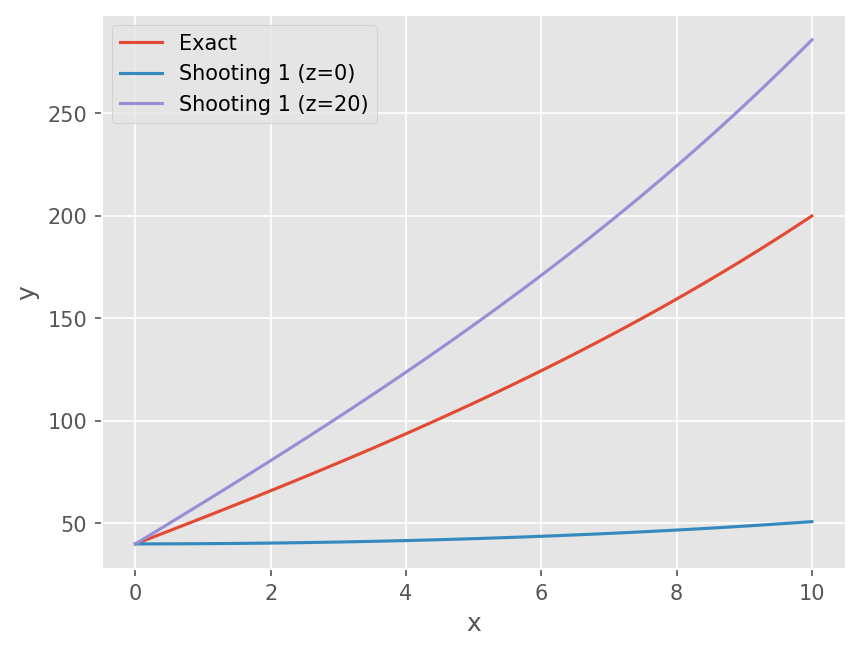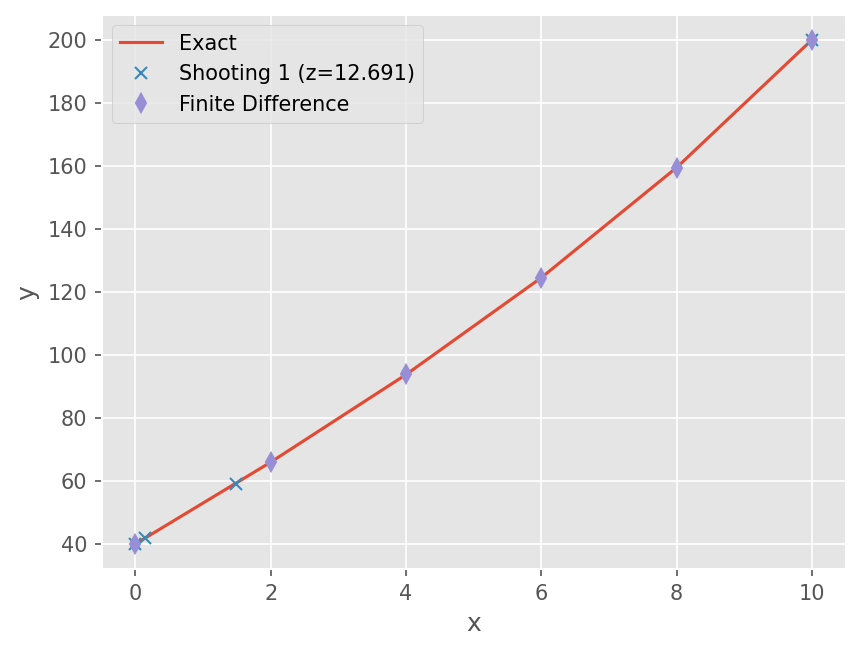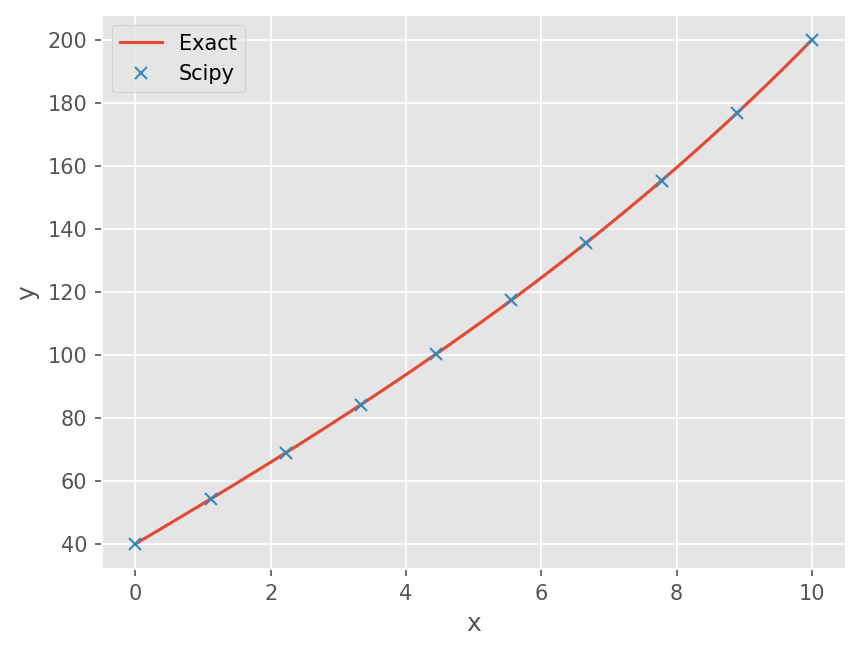Boundary Value Problem#
강좌: 수치해석
Boundary Value Problem#
IVP와 달리 미분 방정식의 양끝단에서 값이 주어진 문제가 있다.
IVP와 같이 미분방정식을 적분해야 하나, 양끝단에 조건이 만족할 수 있어야 한다.
크게 2가지 방법으로 ‘Shooting method’ 와 ‘Finite Difference method’ 가 사용된다.
예제#
다음 예제에 대해서 이들 방법을 설명하고자 한다.
금속 막대에 열전달이 발생하는 경우 Fick’s Law에 의해 다음 방정식이 만족한다.
이때 경계조건은
10m 막대에 대해 다음 변수들로 생각하자. \(T_a=20, T_1= 40, T_2=200, h=0.01\).
이때 이론해는 다음과 같다.
%matplotlib inline
from matplotlib import pyplot as plt
from scipy.integrate import solve_ivp
import numpy as np
plt.style.use('ggplot')
plt.rcParams['figure.dpi'] = 150
# Exact solution
def exact(x):
return 73.4523*np.exp(0.1*x) - 53.4523*np.exp(-0.1*x) + 20
x = np.linspace(0, 10, 101)
# Plot Exact solution
plt.plot(x, exact(x))
plt.legend('Exact')
plt.xlabel('x')
plt.ylabel('y')
Text(0, 0.5, 'y')

Shooting method#
Shooting method는 IVP를 푸는데, 안주어진 초기 조건을 가정해서 경계조건을 만족하도록 shooting 하는 방법이다.
위 예제를 IVP로 풀 경우 다음과 같이 고차 미분항을 보조변수를 이용해 표현한다.
초기조건으로 \(T(0)=T_1\) 주어졌으나 \(z(0)\)는 주어지지 않아서 이를 가정해서 푼다.
solve_ivp를 이용해서 이를 구현하면 다음과 같다.
# Constants
Ta, T1, T2 = 20, 40, 200
h = 0.01
# derivative function
def dydx(t, y):
# y[0], y[1] : T and z
return np.array([y[1], h*(y[0] - Ta)])
# z(0)가 0일 때 해석
z1 = 0
sol1 = solve_ivp(dydx, t_span=(0, 10), y0=[T1, z1], t_eval=x)
# Print result
print(sol1)
# T2
print("T(L) for guess z0={:.3f}: {:.3f}".format(z1, sol1.y[0][-1]))
message: The solver successfully reached the end of the integration interval.
success: True
status: 0
t: [ 0.000e+00 1.000e-01 ... 9.900e+00 1.000e+01]
y: [[ 4.000e+01 4.000e+01 ... 5.063e+01 5.086e+01]
[ 0.000e+00 2.000e-02 ... 2.320e+00 2.350e+00]]
sol: None
t_events: None
y_events: None
nfev: 32
njev: 0
nlu: 0
T(L) for guess z0=0.000: 50.862
# z(0)가 0일 때 해석
z1 = 20
sol2 = solve_ivp(dydx, t_span=(0, 10), y0=[T1, z1], t_eval=x)
# T2
print("T(L) for guess z0={:.3f}: {:.3f}".format(z1, sol2.y[0][-1]))
T(L) for guess z0=20.000: 285.897
초기 추측값으로 실험한 결과 \(z_0 \in (0, 20)\) 일 때 해가 존재한다.
\(z_0\) 값을 바꿔도 되지만, 이를 root finding 기법으로 찾아보자.
root_scalar 함수를 활용하자.
# Plot results of initial guess
plt.plot(x, exact(x))
plt.plot(sol1.t, sol1.y[0])
plt.plot(sol2.t, sol2.y[0])
plt.legend(['Exact', 'Shooting 1 (z=0)', 'Shooting 1 (z=20)'])
plt.xlabel('x')
plt.ylabel('y')
Text(0, 0.5, 'y')

from scipy.optimize import root_scalar
# Root finding function
def obj(z):
sol = solve_ivp(dydx, t_span=(0, 10), y0=[T1, z])
return sol.y[0][-1] - T2
# root finding (Bracketing method)
root = root_scalar(obj, bracket=[0, 20])
print(root)
converged: True
flag: 'converged'
function_calls: 6
iterations: 5
root: 12.690853836888637
# Solve IVP with the root z
sol = solve_ivp(dydx, t_span=(0, 10), y0=[T1, root.root])
# Plot the result of shooting method
plt.plot(x, exact(x))
plt.plot(sol.t, sol.y[0], marker='x', linestyle='none')
# Legend and labels
plt.legend(['Exact', 'Shooting 1 (z={:.3f})'.format(root.root)])
plt.xlabel('x')
plt.ylabel('y')
Text(0, 0.5, 'y')

Finite Differenece Method#
Finite Difference 를 적용하면 양 끝점 사이 \(x\) 를 n 등분 한다.. 이 때 미분을 Finite difference로 표현하면 다음과 같다.
이를 정리하면 다음과 같다
양 끝점의 값은 \(T_0\), \(T_{n}\) 이다.
각 점에서 이 식을 전개하면 다음과 같다.
n-1 개의 연립방정식을 해석한다. 위 예제를 적용하면 다음과 같다.
linalg.solve 함수를 활용해서 해석하는 코드는 다음과 같다.
# Number of division
n = 5
# Array x
x = np.linspace(0, 10, n+1)
dx = np.diff(x)[0]
# Array y
y = np.empty_like(x)
y[0], y[-1] = T1, T2
# Operator
A = np.zeros((n-1, n-1))
for i in range(n-1):
A[i, i] = 2 + h*dx**2
if i > 0:
A[i, i-1] = -1
if i < n-2:
A[i, i+1] = -1
# Forcing term
b = np.ones(n-1)
b *= h*dx**2*Ta
b[0] += T1
b[-1] += T2
# Solve system
y[1:-1] = np.linalg.solve(A, b)
print(y)
[ 40. 65.96983437 93.77846211 124.53822833 159.47952369
200. ]
# Plot numerical results
plt.plot(x, exact(x))
plt.plot(sol.t, sol.y[0], marker='x', linestyle='none')
plt.plot(x, y, marker='d', linestyle='none')
# Legend and Labels
plt.legend(['Exact', 'Shooting 1 (z={:.3f})'.format(root.root), 'Finite Difference'])
plt.xlabel('x')
plt.ylabel('y')
Text(0, 0.5, 'y')

Scipy 활용#
scipy.integrate 모듈 내 BVP 해석 함수도 제공한다.
boundary value problem#
solve_bvp 함수는 경계 조건에 맞게 미분 방정식을 수치적으로 해석한다
from scipy.integrate import solve_bvp
# derivative function
def dydx(t, y):
# y[0], y[1] : T and z
return np.array([y[1], h*(y[0] - Ta)])
# Boundary condition
def bc(ya, yb):
# both ends point as ya and yb
return np.array([ya[0] - T1, yb[0] - T2])
# Array x
n = 10
x = np.linspace(0, 10, n)
y = np.zeros((2, n))
sol = solve_bvp(dydx, bc, x ,y)
# Plot numerical results
x = np.linspace(0, 10, 101)
plt.plot(x, exact(x))
plt.plot(sol.x, sol.y[0], marker='x', linestyle='none')
# Legend and Labels
plt.legend(['Exact', 'Scipy'])
plt.xlabel('x')
plt.ylabel('y')
Text(0, 0.5, 'y')
